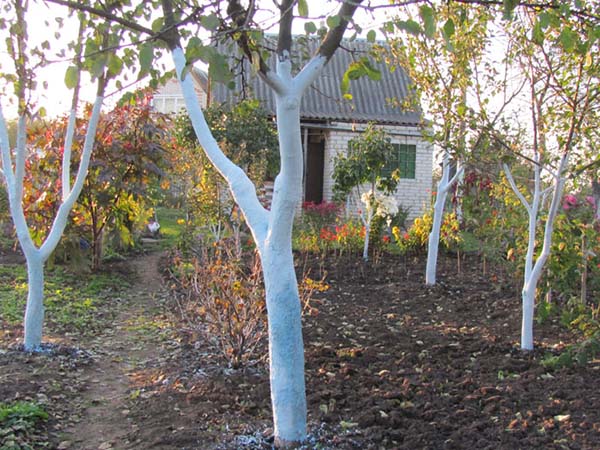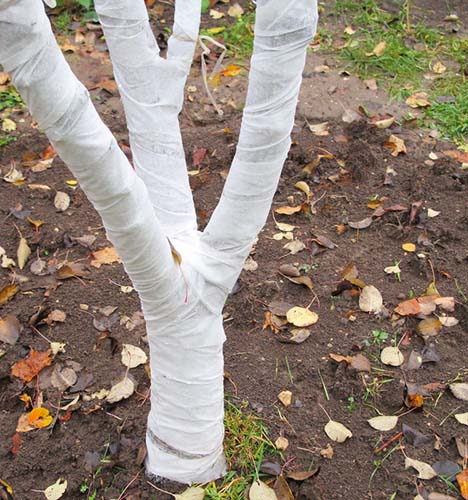Whitewashing garden trees in autumn and spring: terms, compositions of solutions
Some people far from gardening have a strange opinion that trees are whitened for beauty. However, this is not at all the case.
This manipulation is very important for the plant itself for completely different reasons, and to be more precise, it performs most of all a protective function, and not a decorative one. Without a doubt, additional fuss is unlikely to please in a series of autumn worries, but all the costs will be more than compensated by long-term abundant flowering and a rich harvest. So, it would be wiser and more practical not to neglect such a useful and extremely necessary event as whitewashing tree trunks in autumn and spring.

Content
Why do you need to whitewash trees
The answer to the question "Should trees be whitewashed?»In the Central zone (Moscow region), in the Urals and Siberia is unambiguous - "Yes need". But with a little southern exception.
If you live in a very warm region, where there are no subzero temperatures and sudden changes in weather (minus-plus), then based on the main purpose of whitewashing, you practically do not need such a procedure.
By the way! You need to whitewash all garden trees, not just fruit trees (fruit trees).

Why are trees whitewashed, what goals are pursued in this case:
- prevent frost cracks (sunburn) - cracks in the bark that form due to temperature changes (plus or minus) during the transitional winter-spring period.
- to destroy all kinds of insect pests and other parasites, as well as their eggs that are going to winter in the bark (ticks, gold-tails, leafworms, moths, etc.);
- (based on the previous one) protect the bark from pests, pathogenic microorganisms and bacteria;
- simultaneously carry out a kind of treatment and disinfection of wounds;
- and last but not least to make the garden more colorful and attractive (aesthetics).
Video: why and how to whiten trees
Is it possible to whitewash young trees
Some novice gardeners believe that whitewashing can, on the contrary, only harm young trees. However, this is not at all the case, if, of course, certain rules are followed.

Trees are whitewashed both old and young. But on young seedlings, weaker solutions should be used (if you use lime, then its concentration should be reduced by 2 times) so as not to burn the young bark. Or you can use special paints for whitewashing garden trees, for example, the same water-based or water-dispersible paints, or acrylic paints. But it is imperative to whitewash, since young seedlings have a very thin bark, which can easily be damaged in late winter or early spring from sunburn (burst due to temperature differences).
By the way! There is a not unfounded opinion that it is better not to whiten very young seedlings with a smooth bark, but to wrap the trunk with white covering material (spunbond ribbons). This way you not only prevent sunburn, but also protect the seedling from rodents.

Video: protecting young fruit trees from sunburn with whitewashing
When to whitewash trees
In the opinion of most gardeners, whitewashing of garden trees should be carried out 2 times a year - in spring and autumn. But it just so happened that most often inexperienced summer residents whitewash in the spring (perhaps because of the Soviet experience of spring subbotniks), although the main and most important is considered exactly autumn whitewash.
But there is also additional summer whitewash, which is resorted to only if you either whitewashed the trunk poorly, or used non-waterproof compounds that washed off the rains.
Whitewashing trees in autumn: terms, goals, features
As for certain dates, experienced gardeners recommend whitewashing trees in the fall, when the air temperature drops to + 3-5 degrees (but not less than 0, that is, the procedure must be performed at positive temperatures), prolonged autumn rains will end, and all the leaves will fall , that is, approximately in the month of October - November.
By the way! Under certain circumstances (if you use exclusively high-quality and waterproof composition), you can do only with autumn whitewashing, because it is considered the most effective.
It should be understood that it does not matter whether it is a young tree or an old one. If it was not whitewashed in the fall, then at the end of winter - early spring (as a rule, this is February-March), it can get a sunburn (frost cracks form on the trunk).

Interesting! What is a sunburn of a tree (frostbite) and how does it happen?
When in February-March the daytime temperature rises to + 8-10 degrees, and at night it drops below 0 degrees, then during the day the tree perceives such a high temperature as a signal to start sap flow. With the onset of night and sub-zero temperatures, all the juice that ended up in the bark crystallizes (freezes), and the bark simply cracks from such a temperature drop (tissue rupture occurs = frost cracks).Although, according to other sources, cracking occurs due to thermal expansion and contraction of the wood itself.
To prevent this from happening, the trunk is whitewashed, because the white color perfectly repels the sun's rays.
Video: how to whitewash trees in autumn: whitewashing secrets
Whitewashing trees in spring:terms, goals, features
Spring whitewashing (better even say early spring), as a rule, is carried out if, for some reason, the autumn was not carried out. Or if it has washed off or has peeled off badly, therefore it is also called repeated or, in a way, renewing.

The whitewashing of trees in spring begins when the thermometer reaches positive values, that is, at a temperature above 0. At the same time, it is important to have time before the buds open and the foliage appears (if there is still snow, then it is possible at this time), in other words, the approximate period of spring whitewashing - this is the end of February-March.
Thus, the main goals (advantages) of spring whitewashing of trees are:
- updating the autumn whitewash to improve protection;
- retention of bud opening (to postpone flowering and protect from recurrent spring frosts);
- prevention against pests and diseases (fungicides must be included in the composition, such as copper or ferrous sulfate)
- beauty, as whitewashed trees will look much more decorative.
Video: whitewashing trees in spring - a recipe for life-giving bark balm
However! Many professional agronomists believe that spring whitewashing is a meaningless activity that performs only a decorative function, but not the main one - a protective one.
How to whitewash trees: preparatory work and whitewashing technique
That the procedure was most effective, before performing the whitewashing of the trunk itself, the tree must first be prepared:
- If necessary and desired, carefully clean the stem (trunk) from the old dead bark, and get rid of various mosses and lichens... At the end of the work, all the garbage must be collected and must be removed from the site, or it is better to just burn it.
- Disinfect the trunk, all wounds and cracks by treating copper or iron vitriol (3% solution), or by preparing an ash and soap solution (200 grams of ash, 40 grams of liquid soap or dishwashing detergent for 10 liters of warm water).
- Then fill up all deep wounds, hollows, cracks and cracks with clay or garden pitch (but according to many gardeners, its use during this period is undesirable).
Video: which is better - garden var or clay
Only after completing these procedures, you can proceed directly to whitewashing.
Video: preparing a tree for whitewashing
Important! As mentioned earlier, it is necessary to whitewash at positive temperatures. Moreover, it is advisable to choose a dry and clear day so that the whitewash dries quickly and is well fixed.
What is better to whiten? To whitewash a tree trunk it is convenient to use:
- flat flute brush;
![]()
- a special brush from a washcloth (paint brush or scrubber);
- paint roller;
- spray gun (if you need to whitewash a lot).
To what height should the trees be whitened? Some gardeners believe that the higher the better, but still, as a rule, the trees are whitened from the ground and down to the base of the skeletal branches, that is, the entire stem (from the root collar to the first skeletal branch of the lower tier), although it is highly recommended capture the lower skeletal branches by 1/3.

Video: how to prepare and whitewash trees in autumn
How to whitewash trees: whitewash compositions
The composition of solutions for whitewashing trees, as a rule, can include the following components (optional), each of which performs a specific function:
- slaked lime (gives whitewash a white color);
By the way! In order to make slaked lime from quicklime granulated lime (it is in this form it is most often sold), you need to extinguish 3 kg of lime with 6-8 liters of water - pour water into a bucket and add lime, and then stir with a stick for 20-40 minutes until complete dissolution and cooling of the solution (due to the reaction, the temperature will increase significantly), at least up to + 35-40 degrees).
- chalk (again to make the whitewash white);
- fireclay or ordinary clay (needed for viscosity - sticking, so that it is convenient to repair various small damages on the bark);
- casein glue or PVA (improves adhesion so that the composition is not washed off for a long time by rains);
- milk (for sticking);
- soap (for better adhesion);
- copper or inkstone (antiseptic, that is, for disinfection);
Important! inkstone cannot be mixed with lime, unless with chalk.
- cow dung or mullein (to feed the plant, a kind of foliar fertilization through the bark);
- special acrylic, water-based and water-dispersion paints for whitewashing trees (a ready-made composition to which you can add only manure, but sometimes it is added to a lime solution for better adhesion).
![]()
Contradictory! Many amateur summer residents believe (are mistaken) that special whitewashing paints do not allow the bark of trees to breathe normally, therefore it is better to limit their use only to adult specimens.According to other more trustworthy sources, on the contrary, they are excellent for whitewashing young plants.

Recipes for the most popular and effective compositions for whitewashing trees in autumn and spring:
- 200-300 grams copper sulfate , 3 kg of slaked lime, 5 kg of clay, 100 ml of mullein (or 1 kg of fresh manure) for 5-6 liters of water (very strong concentration, for an old tree);
- 200-300 grams of copper sulfate, 3 kg of slaked lime, 1 kg of clay, 1 kg of fresh cow dung (or 100 ml of mullein) and 100 grams of PVA glue for 5-6 liters of water (for a middle-aged already fruiting plant);
- Dissolve 2 kg of quicklime in 5-6 liters of water, add 1 kg of special acrylic paint for whitewashing trees (lighter composition, suitable for young seedlings);
- You can prepare a composition for whitewashing yourself, mixing suitable components in certain proportions (for example, if you forgot to spend eradicating the treatment of the garden from pests and diseases, then you should definitely add copper or iron vitriol to the whitewash; if poorly fed, then - mullein or cow dung), so that in the end you get a rather dense and sticky solution.
Note!To whitewash very young trees (2-3 years old), the lime concentration should be reduced by 2 times from the recommended one.
The gardening season does not end with the first snow. It is possible and even very necessary to prepare the garden in advance for winter and spring. For this, whitewashing of tree trunks serves as best as possible, which prevents sunburn, and also gives them a more well-groomed look.
Video: whitewashing fruit trees



